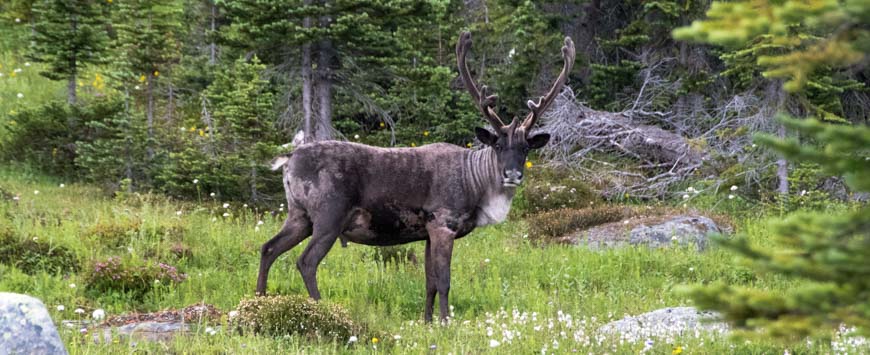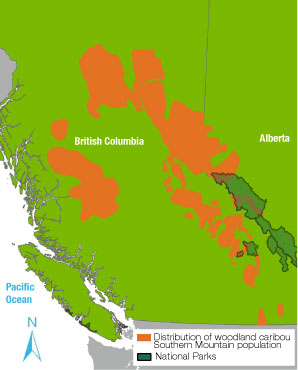
Southern Mountain Caribou Conservation
Woodland caribou

Distribution of woodland caribou Southern Mountain population
Woodland caribou are found in the boreal forests and mountain regions of Canada from Newfoundland to British Columbia and north into the Yukon and the Northwest Territories. They are a medium-sized member of the deer family, rich brown in colour with white necks. Unlike the great herds of barren-ground caribou to the north, woodland caribou are usually found in small groups. They live in old growth forest and high alpine areas. These often hard-to-access areas help them avoid predators.
Caribou found in Jasper National Park belong to the Southern Mountain population of woodland caribou. They are distinct from most other woodland caribou in their use of mountain habitat. They do not migrate like many other caribou but rather move elevationally in response to seasonal changes.
The Southern Mountain population of woodland caribou has declined across western Canada. Listed as a Threatened species under Schedule 1 of the Species at Risk Act (SARA), Southern Mountain caribou range includes parts of Mount Revelstoke, Glacier, Jasper and Banff National Parks.
Protecting critical habitat
Parks Canada has a legal obligation to prevent the destruction of caribou critical habitat. In the mountain national parks, significant critical habitat protection measures are already in place.
What actions are being taken to protect critical habitat?
- Monitoring and management activities to reduce predation risk;
- Maintenance and protection of old-growth habitat;
- Consideration of critical habitat protection in fire and vegetation management plans and integrated land-use planning;
- Adjustments to the timing of winter access in areas of caribou habitat; and
- Reduced speed zones and/or caribou crossing signs on roads through critical habitat.
Conservation and recovery strategies
Conservation Strategy
Parks Canada's Conservation Strategy for Southern Mountain Caribou in Canada’s National Parks (PDF, 2.7 MB) has guided caribou conservation actions in the mountain national parks of Banff, Jasper, Mount Revelstoke and Glacier since its completion in 2011. The strategy identifies five key threats to woodland caribou populations in the mountain parks and actions proposed to reduce these threats. Each action may or may not be applicable in all four of the mountain national parks (Banff, Jasper, Mount Revelstoke and Glacier).
1. Changes to predator-prey populations in and around caribou habitat
- Keep primary prey for caribou predators low by preventing “elk refuges”
- Monitor predator populations to anticipate their impact on caribou recovery
- Maintain and monitor caribou population size and habitat
2. Facilitated access for predators to caribou
- Provide visitors with opportunities for recreation in areas not important for caribou while restricting recreation in caribou habitat
- Discontinue setting early season ski tracks that lead to caribou winter habitat
3. Direct disturbance
- Reduce speed zones on roads through important habitat
- Implement periodic seasonal trail and road closures
- Relocate trails away from important caribou habitat
- Educate park visitors to avoid disturbing caribou
4. Habitat loss
- Use prescribed fire in areas away from caribou habitat to maintain a safe distance between caribou and their predators
- Use prescribed burns to guard against large fires within caribou habitat
- Development within important caribou habitat to be considered under exceptional circumstances only, and must not adversely affect caribou
5. The increased threats faced by populations that have already become dangerously small
- Re-introduce or add caribou where herd sizes are critically low
- Manage other threats to prevent caribou populations from becoming small
Recovery strategy
The Recovery Strategy for the Woodland Caribou, Southern Mountain population (Rangifer tarandus caribou) in Canada (2014) guides recovery actions for the species across its range including the mountain national parks. Parks Canada, along with the provinces of Alberta and British Columbia, worked with Environment Canada to help provide the best available information, technical advice and perspectives for the preparation of the recovery strategy.
Action Plans
In managing species at risk and their critical habitat, Parks Canada abides by the Species at Risk Act (SARA) which requires action plans be prepared for species at risk. Action plans for Southern Mountain caribou in Banff, Jasper, Mount Revelstoke, and Glacier national parks are included in multi-species actions plans published in 2017.
Species at risk, their residences, and their habitat are protected by existing regulations and management regimes in national parks and national historic sites as well as by SARA. Park-specific objectives are identified in action plans to help recover and/or manage the identified species, to be met through a number of recommended management activities. These activities represent the site’s contribution to objectives presented in federal recovery strategies and management plans. These measures were identified based on threats and actions outlined in federal and provincial status assessments and recovery documents, as well as knowledge of the status and needs of each species. Population monitoring measures are also identified for the species for which management activities at the sites can contribute to recovery objectives.
Learn more about caribou conservation in the mountain parks
- Date modified :
